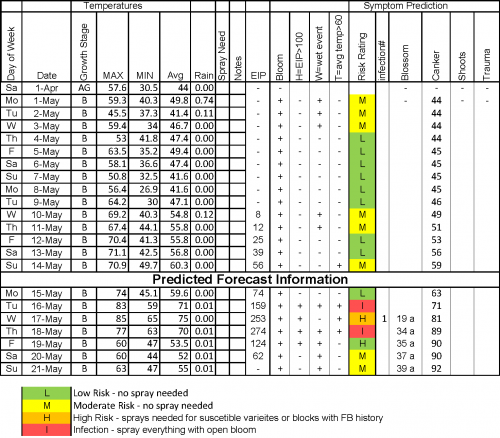West Michigan tree fruit update – May 16, 2017
Warmer weather brings disease and insect threats back to the forefront.
Weather and crop development
For more than a week, temperatures were much below normal and this halted tree fruit development. The warmer weather in the past few days has moved many apples into petal fall for the major bloom, but a lot of bloom remains on 1-year-old wood. It is still much too early to fully determine fruit injury due to freezing temperatures a week ago. There is some damage, but there are many viable flowers as well, which will lead to an apple crop that still needs to be protected.
Trees are going to respond to the warmer weather with fairly rapid growth. Second applications of prohexidione calcium (Apogee, Kudos) are needed. Rapid leaf development will require a tighter fungicide program to be sure newly developing leaves are well-covered for apple scab infections.
Disease update
Most Michigan State University Enviroweather stations in the area have degree-day (DD) accumulations from first apple scab spore catch between 800 and 850 base 32. This indicates roughly that 98 percent of primary scab spores are mature and primary scab fungicide rates and protection levels need to be maintained. I estimate we will reach 1,000 DD32 in a week or so and all spores will be matured at that time. Then, we typically require several daytime rain events to discharge the mature spores, so we have at least two weeks of primary scab to protect for and maybe even three weeks depending on the time of day, duration and amount of rainfall.
The wetting event on May 15 into the 16 is not an infection for most areas around Grand Rapids, Michigan, but if we get additional rain in the early afternoon, rewetting could occur and extend the potential wetting period to make an infection.
Powdery mildew risk returns with the warm and humid weather expected this week. MSU Extension suggests considering a fungicide with mildew activity as you cover up for apple scab.
With the return of warm weather and open bloom still present, the risk for fire blight blossom blight returns and cover sprays for susceptible varieties are needed this week. Preferably, cover ahead of the rain events. With the warm front comes the risk for hail and high winds, so watch for that as well. Even a very light rain could get a serious blossom blight infection started in the next four or five days.
The EIP is going up well over 200 with warm temperatures and potential rain. It is always best to protect for blight ahead of a rain event, especially when using oxytetracycline, Serenade and Kasumin. Streptomycin (where no resistance is documented) has some systemic action that allows us to come back within 24 hours after an infection, but the other materials do not. You should consider covering blight-susceptible varieties with open bloom for all rain events this week.
This is exactly how we got the fire blight problems that showed up in 2016—on the late, ragtag bloom on 1-year-old wood. Don’t let this get by you and cover up these blocks that need it.
The table below shows the risk ratings according to the MaryBlyt model using the Sparta Enviroweather station data. Cooler weather over the weekend will reduce the fire blight risk, but don’t miss covering for the next few days.

Fire blight risk ratings as of May 15, 2017, in Sparta, Michigan.
Insect pest update
Once you get your bees out, it will be time to get petal fall sprays on for mites, plum curculio and other miscellaneous pests that have been hunkered down waiting for nicer weather. I expect codling moth will start flying this week as well, so have your traps up to set an accurate biofix.



 Print
Print Email
Email


